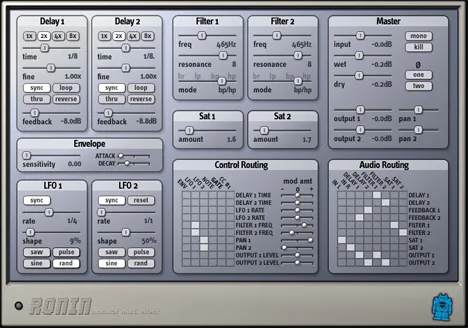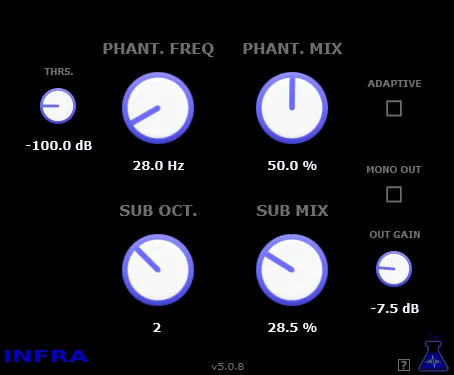Audio Damage’s Ronin isn’t just a multi-effect plugin; it’s a true analog-style sound laboratory, combining the power of classic devices with unprecedented routing flexibility. Designed for musicians and sound engineers seeking to go beyond the ordinary, Ronin offers a unique combination of two delays, two multi-mode filters, two tube saturation stages, and two LFOs (low-frequency oscillators), complemented by a fully routable signal path.
From subtle analog textures to complete audio destruction, Ronin is a comprehensive solution for creating complex and original effects. Thanks to the “bucket-brigade” delay modeling, it is capable of reproducing the sound of tape effects, creating true analog chorus, extreme flangers, and amazing pitch effects.
Key features of Ronin
At the heart of Ronin are its powerful and flexible modules, which can be combined in any way thanks to the innovative routing matrix.
Delay Modules
- Modeled on the principle of analog “bucket-brigade” devices.
- Changing the delay time causes a change in pitch, allowing you to create unique “pitch bombs,” chorus effects, pitch-shifting flangers, and tape delay simulations with flutter.
- Both delay modules support synchronization with the host DAW.
- Infinite loop and reverse modes available.
- Positive feedback support (> 50%) to create effects of overloaded oscillation and sound destruction.
Filter Modules
- Multi-mode filters with continuously variable output types: notch, lowpass, bandpass, and highpass.
- Capable of self-oscillation at high resonance values, allowing them to be used as synthesizer elements or to create extreme effects.
Low Frequency Oscillators (LFOs)
- A pair of LFOs with four waveforms: sine, sawtooth, pulse, and random.
- Smooth adjustment of the waveform with a single control.
- The LFO rate can be a modulation target, allowing the LFO to modulate itself to create very unusual waveforms.
- Both LFOs can be synchronized with the MIDI host.
- The waveform of the second LFO can be reset by the first LFO, opening up additional possibilities for complex modulations.
Saturation Modules
- Two stages of “tube” saturation.
- Allow you to add warmth and density to the sound (slight smoothing) or create intense tube distortion, giving the sound aggressiveness and character.
Routing Matrix
This is perhaps the most powerful feature of Ronin. The matrix provides full control over the signal path, both audio and control signals. The user can route signals as they see fit, without any restrictions.
- An extremely flexible routing system allows you to create unique and extreme patches.
- Want to return the filters’ output back to their input? No problem!
- Want to insert distortion and resonance into the delay feedback loop? Please!
- Ronin is entirely in your hands, allowing you to experiment and find new sound solutions.
Other features
- MIDI Learn: Each control in the Ronin interface can be easily assigned to an external MIDI controller with a simple combination of clicks.
- MIDI as a modulation source: MIDI notes, modulation wheel, and gate signal can be used as modulation sources in the routing matrix, expanding the possibilities of controlling effects.
- Envelope Follower: An additional modulation source that generates control signals based on the level of the input audio signal. It has separate sensitivity, attack, and decay settings for precise shaping of the modulation dynamics.
Audio Damage’s Ronin is an inexhaustible source of inspiration for creating unique soundscapes. Its combination of classic analog effects and modern routing flexibility makes it an indispensable tool for both sound design and the processing of musical instruments and vocals. Add Ronin to your plugin arsenal and discover new horizons for your creativity!



